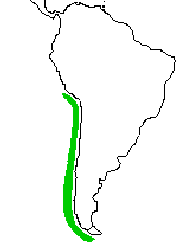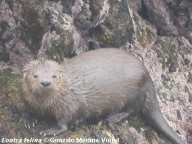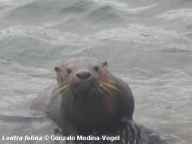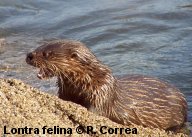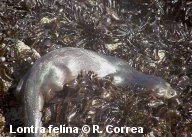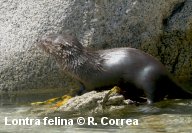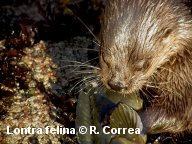 |
Last Update:
Sunday February 22, 2015 |
| •[Home] | [Site Map] | [Contact Us]• | |
| [Home] | [Members] | [News] | [Bulletin] | [Q & A] | [Species] | [Library] |
Lontra felina (Molina, 1782), the Marine Otter (currently being revised)
|
|
DescriptionThis is the smallest of the New World otters, being about 1m long, weighing about 5kg. The fur is rather harsh in texture, darkest brown on the back, somewhat paler on the underside, chin, cheeks and throat. The claws are blunt and the ends of the toes are free of webbing. The tail is relatively short compared to other otters. The head is flattened, with a short muzzle and abundant, strong whiskers - this gives it the name Sea Cat, although it more closely resembles an Asian Small-Clawed Otter. The teeth are large, modified for slicing not crushing. Pairs tend to stay together, and have been seen cooperating to bring large prey to shore. The main food of the Marine Otter is Crustaceans, Molluscs and Fish, though the proportion varies with location. They prefer omnivorous or carnivorous prey from the inter/sub tidal zone - for example, they rarely take echinoderms despite their abundance. The usual main component of the diet is crabs, such as the Chilean King Crab or la Centolla (Lithodes antarctica). They also have a taste for freshwater prawns (Criphiops caementarius), and will follow freshwater streams high above sea level to find them. They have been seen attacking sea birds. At certain times of year, they seek out and eat fruit from coastal shrubs. HabitatThis species is found in the temperate coastal and tropical coastal biomes. They prefer to live along rocky coasts of irregular topography, exposed to heavy swells and strong prevailing winds (northeasterlies, westerlies and southwesterlies). They like large, rocky outcrops with lots of crevices and caves to hide in, and which harbour prey. Steep but stable rocky slopes and cliffs are favoured - Marine Otters make no use of sandy beaches except when travelling across them to other rocky areas. The otters range up to 30m (100') inland, and like a dense vegetation of shrubs and bushes. Dens are crevices and caves, preferably with tunnels leading to sea and landward; the seaward entrance is often only exposed at high tide. Preferred sites have thick vegetation above, difficult access from land (for predators), and are near feeding patches and offshore rocks in shallow water protected from winds. Dens are used for birth, feeding, resting, sleeping and sprainting. DistributionThis species ranges from Chimbote, central Peru, in the north to Cape Horn and the Estrecho de le Maire (Strait of Le Maire) in the south of Chile. It is possible that the species still occurs near Isla de los Estados (Staten Island) off the southern tip of Argentina. Conservation StatusRed List Category EN (Endangered) population trend decreasing Accelerating habitat destruction and degradation, reduction of prey biomass due to competition with man, direct persecution by aquaculturalists, poaching, killing by dogs and entrapment in fishing gear mean it is likely that this species will continue to decline by around 50% over the next ten years. (Source: IUCN Red List) Current ConcernsThe Marine Otter is still poached for its pelt in Chile and Peru. The IUCN/SSC Otter Specialist Group state that marine otters are threatened by: pollution of nearshore areas with heavy metals and other contaminants, intense harvesting of littoral and sublittoral seaweed especially kelps which may reduce productivity and abundance of shellfish, over exploitation by fishermen of nearshore shellfish and fishes, killing by fishermen who see the Marine Otter as a competitor for fish and shellfish stocks, fishing techniques that result in the accidental capture and drowning of otters in nets Leading ResearchersGonzalo Medina Vogel, Juliana de Abreu Vianna, Claudio Delgado-Rodriguez Key PublicationsGeneral
Ecology
Useful Links
|
| [Copyright � 2006 - 2011 IUCN OSG] | [Home] | [Site Map] | [Contact Us] |

